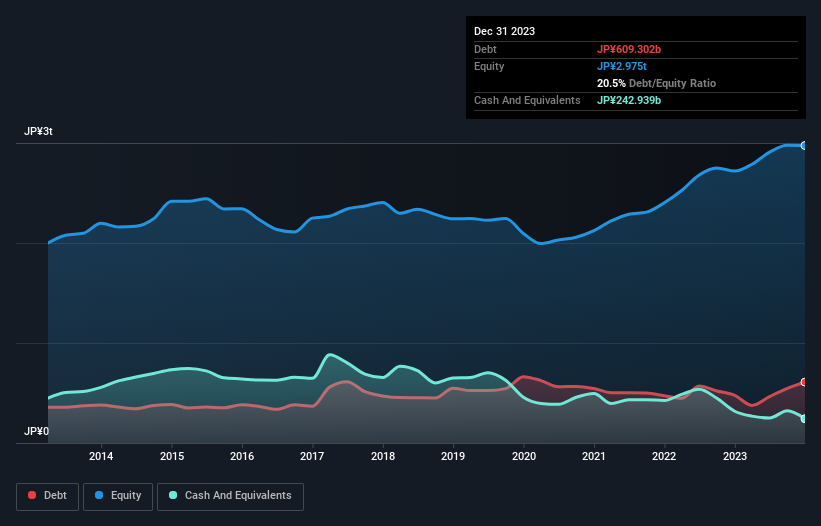- Japan
- /
- Tech Hardware
- /
- TSE:4901
These 4 Measures Indicate That FUJIFILM Holdings (TSE:4901) Is Using Debt Reasonably Well

Howard Marks put it nicely when he said that, rather than worrying about share price volatility, 'The possibility of permanent loss is the risk I worry about... and every practical investor I know worries about.' So it might be obvious that you need to consider debt, when you think about how risky any given stock is, because too much debt can sink a company. As with many other companies FUJIFILM Holdings Corporation (TSE:4901) makes use of debt. But the real question is whether this debt is making the company risky.
When Is Debt A Problem?
Debt assists a business until the business has trouble paying it off, either with new capital or with free cash flow. If things get really bad, the lenders can take control of the business. While that is not too common, we often do see indebted companies permanently diluting shareholders because lenders force them to raise capital at a distressed price. Having said that, the most common situation is where a company manages its debt reasonably well - and to its own advantage. When we think about a company's use of debt, we first look at cash and debt together.
Check out our latest analysis for FUJIFILM Holdings
What Is FUJIFILM Holdings's Debt?
The image below, which you can click on for greater detail, shows that at December 2023 FUJIFILM Holdings had debt of JP¥609.3b, up from JP¥477.3b in one year. On the flip side, it has JP¥242.9b in cash leading to net debt of about JP¥366.4b.

How Strong Is FUJIFILM Holdings' Balance Sheet?
We can see from the most recent balance sheet that FUJIFILM Holdings had liabilities of JP¥1.13t falling due within a year, and liabilities of JP¥442.7b due beyond that. Offsetting this, it had JP¥242.9b in cash and JP¥625.0b in receivables that were due within 12 months. So its liabilities total JP¥706.3b more than the combination of its cash and short-term receivables.
Of course, FUJIFILM Holdings has a titanic market capitalization of JP¥3.87t, so these liabilities are probably manageable. However, we do think it is worth keeping an eye on its balance sheet strength, as it may change over time.
We use two main ratios to inform us about debt levels relative to earnings. The first is net debt divided by earnings before interest, tax, depreciation, and amortization (EBITDA), while the second is how many times its earnings before interest and tax (EBIT) covers its interest expense (or its interest cover, for short). The advantage of this approach is that we take into account both the absolute quantum of debt (with net debt to EBITDA) and the actual interest expenses associated with that debt (with its interest cover ratio).
FUJIFILM Holdings has a low debt to EBITDA ratio of only 0.87. And remarkably, despite having net debt, it actually received more in interest over the last twelve months than it had to pay. So it's fair to say it can handle debt like a hotshot teppanyaki chef handles cooking. And we also note warmly that FUJIFILM Holdings grew its EBIT by 12% last year, making its debt load easier to handle. There's no doubt that we learn most about debt from the balance sheet. But it is future earnings, more than anything, that will determine FUJIFILM Holdings's ability to maintain a healthy balance sheet going forward. So if you want to see what the professionals think, you might find this free report on analyst profit forecasts to be interesting.
But our final consideration is also important, because a company cannot pay debt with paper profits; it needs cold hard cash. So we clearly need to look at whether that EBIT is leading to corresponding free cash flow. Over the last three years, FUJIFILM Holdings reported free cash flow worth 6.1% of its EBIT, which is really quite low. That limp level of cash conversion undermines its ability to manage and pay down debt.
Our View
When it comes to the balance sheet, the standout positive for FUJIFILM Holdings was the fact that it seems able to cover its interest expense with its EBIT confidently. But the other factors we noted above weren't so encouraging. For instance it seems like it has to struggle a bit to convert EBIT to free cash flow. When we consider all the elements mentioned above, it seems to us that FUJIFILM Holdings is managing its debt quite well. Having said that, the load is sufficiently heavy that we would recommend any shareholders keep a close eye on it. Above most other metrics, we think its important to track how fast earnings per share is growing, if at all. If you've also come to that realization, you're in luck, because today you can view this interactive graph of FUJIFILM Holdings's earnings per share history for free.
If you're interested in investing in businesses that can grow profits without the burden of debt, then check out this free list of growing businesses that have net cash on the balance sheet.
New: AI Stock Screener & Alerts
Our new AI Stock Screener scans the market every day to uncover opportunities.
• Dividend Powerhouses (3%+ Yield)
• Undervalued Small Caps with Insider Buying
• High growth Tech and AI Companies
Or build your own from over 50 metrics.
Have feedback on this article? Concerned about the content? Get in touch with us directly. Alternatively, email editorial-team (at) simplywallst.com.
This article by Simply Wall St is general in nature. We provide commentary based on historical data and analyst forecasts only using an unbiased methodology and our articles are not intended to be financial advice. It does not constitute a recommendation to buy or sell any stock, and does not take account of your objectives, or your financial situation. We aim to bring you long-term focused analysis driven by fundamental data. Note that our analysis may not factor in the latest price-sensitive company announcements or qualitative material. Simply Wall St has no position in any stocks mentioned.
About TSE:4901
FUJIFILM Holdings
Provides products and services in the fields of healthcare, electronics, business innovation, and imaging in Japan, the United States, Asia, and internationally.
Flawless balance sheet and good value.
Similar Companies
Market Insights
Community Narratives



